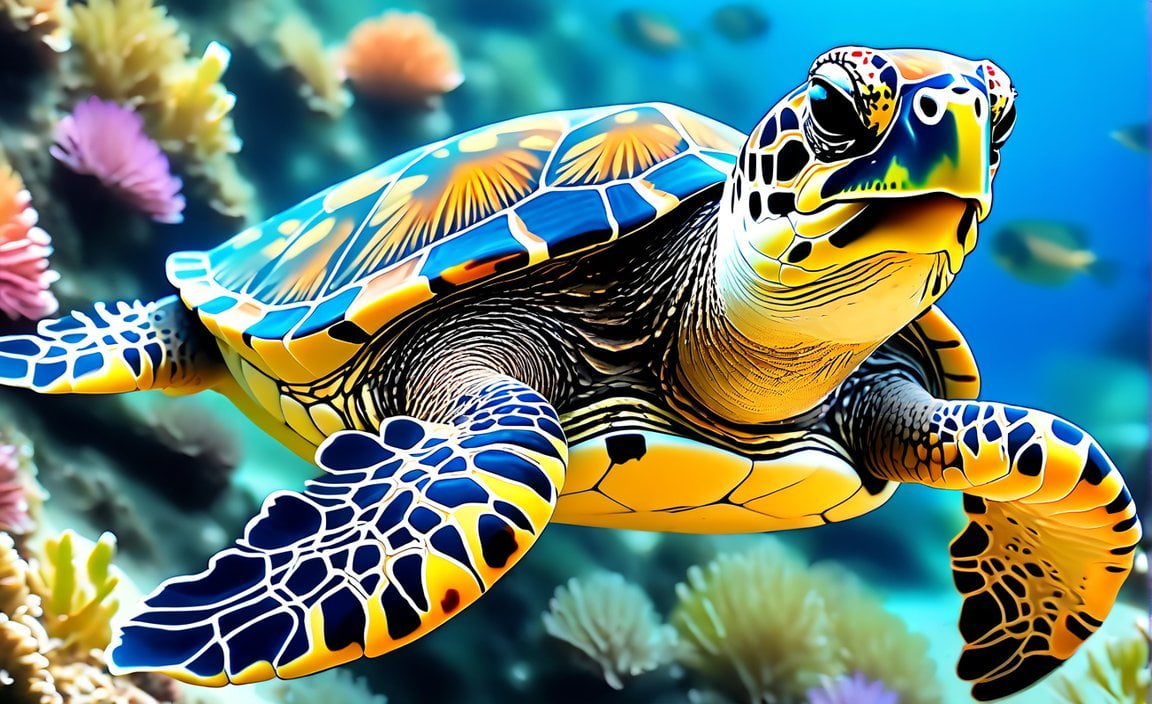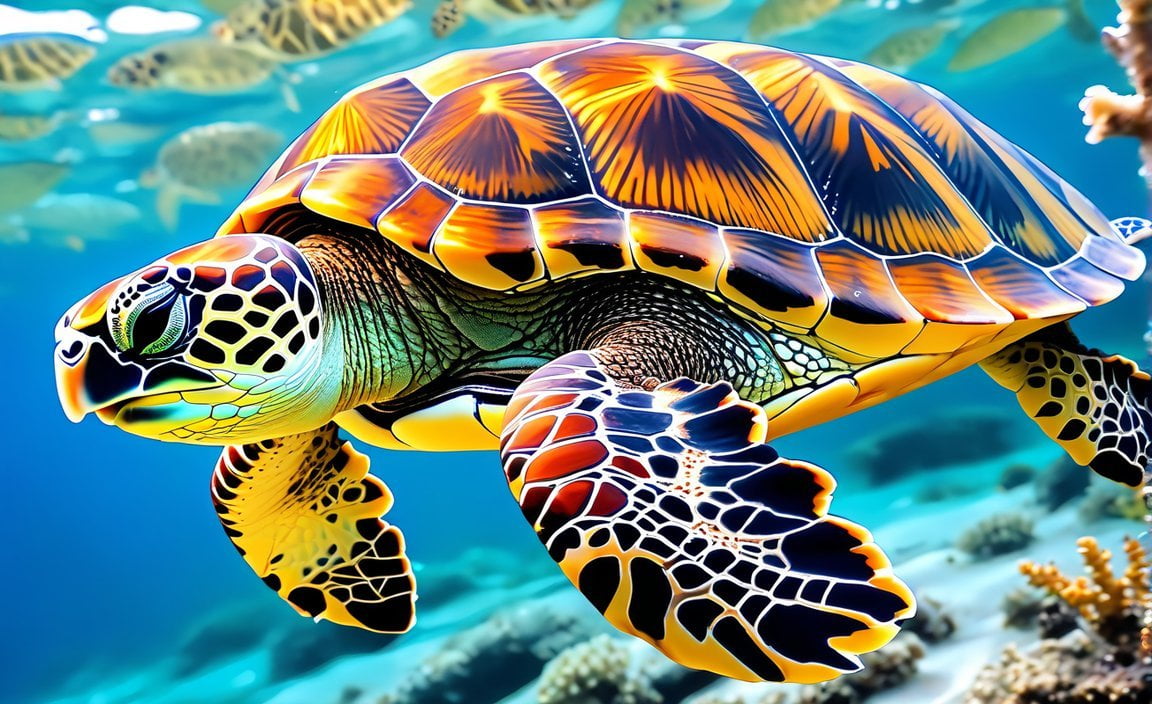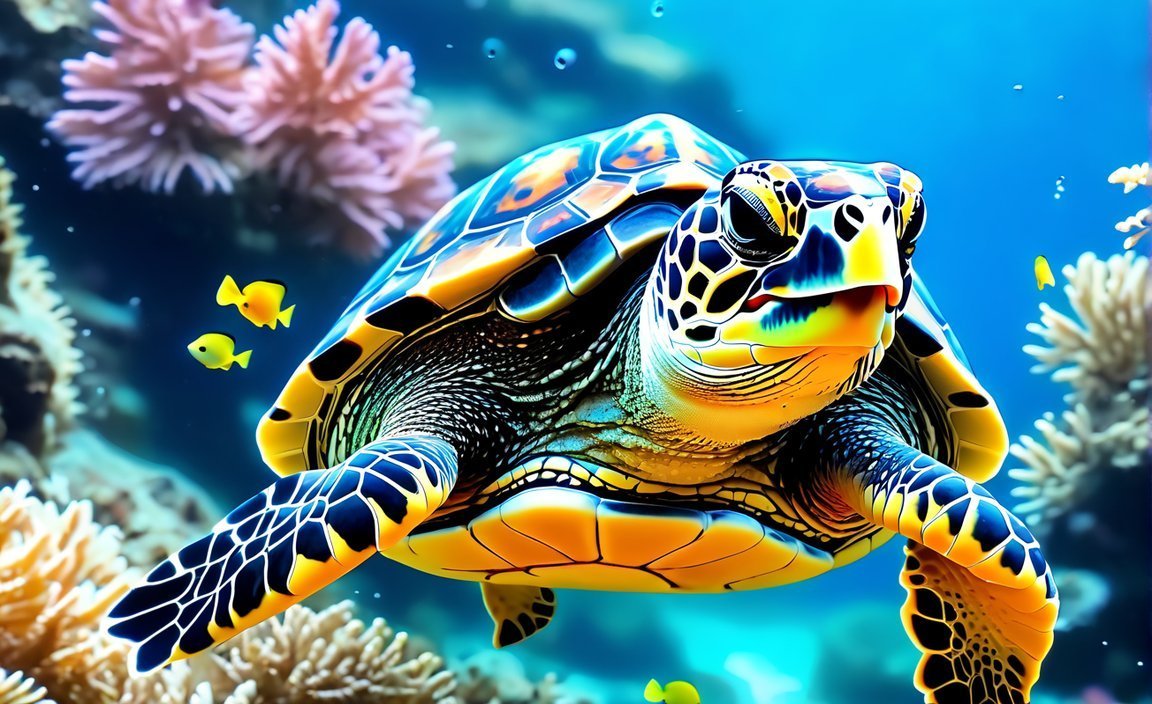Discover 10 Fascinating Facts about Hawksbill Turtles: Conservation & Wildlife Insights

As you delve into the world of hawksbill turtles, prepare to be captivated by their remarkable nature and the urgent need for their conservation. These ocean-dwelling creatures possess an enigmatic charm that lies in their intriguing behaviors and the challenges they face. In this article, we will unveil ten captivating facts about hawksbill turtles, shedding light on their incredible adaptations, crucial role in marine ecosystems, and the conservation efforts required to ensure their survival. Through these insights, we hope to inspire a deeper appreciation for these magnificent creatures and encourage active participation in their preservation for generations to come.
Key Takeaways:
- Hawksbill turtles have unique features such as a long, narrow head and a sharp, bird-like mouth.
- They play a crucial role in maintaining the health of coral reefs by feeding almost exclusively on sponges.
- Hawksbill turtles are solitary nesters and can lay up to 800 eggs in just two months.
- They are the most endangered sea turtle population globally due to human activities such as hunting.
- The largest populations of hawksbill turtles are found in tropical seas.
- The flesh of hawksbill turtles is harmful to humans and is not suitable for consumption.
- Despite being small in size, hawksbill turtles are known for their speed and agility in the water.
- Their overlapping shell plates with serrated edges make them easily recognizable.
- Hawksbill turtles are the fastest swimmers among sea turtles.
- Conservation efforts are crucial to protect and restore the populations of hawksbill turtles, as they are vital for the health of coral reef ecosystems.
## 10 Interesting Facts about Hawksbill Turtles
**1. Distinguishing Features and Naming**
Hawksbill turtles, scientifically known as Eretmochelys imbricata, get their name from their distinctive narrow head and sharp, bird-like mouth. These unique features resemble a beak, giving these sea creatures their recognizable name[^1^][^2^].
**2. Feeding Habits**
When it comes to their diet, hawksbill turtles have a preference for sponges. They are known to feed almost exclusively on these marine organisms, making them essential contributors to the health of coral reefs[^1^][^3^].
**3. Nesting Behavior**
Hawksbill turtles exhibit fascinating nesting behavior. They are solitary nesters and typically nest around four times per season. Each nest can hold approximately 140 eggs, which are laid two weeks apart. In just two months, a maximum of 800 eggs can be laid[^1^].
**4. Endangered Status**
Tragically, hawksbill turtles are currently the most endangered sea turtle population worldwide. Human activities such as hunting have contributed to their decline, and they were even brought to the brink of extinction in the past[^1^].
**5. Population Distribution**
You can mainly find the largest populations of hawksbill turtles in tropical seas. These stunning sea creatures thrive and contribute to the rich biodiversity of these warm marine habitats[^1^].
**6. Harmful Flesh**
While hawksbill turtles are undoubtedly fascinating, their flesh is not suitable for human consumption. In fact, it can be harmful to our health, so it's best to view and appreciate them in their natural habitats[^1^].
**7. Size and Speed**
Hawksbill turtles may be small in size, but they are renowned for their speed in the water. They are considered the fastest swimmers among all sea turtle species, gracefully navigating through the ocean currents[^2^].
**8. Importance in Coral Reef Ecosystems**
These incredible creatures play a crucial role in maintaining the health of coral reef ecosystems. By feeding on sponges, hawksbill turtles help prevent overgrowth that can suffocate corals. Their presence ensures the balance and thriving biodiversity of these fragile systems[^3^].
**9. Unique Shell**
Hawksbill turtles have an unmistakable shell. Its unique appearance is characterized by overlapping plates with serrated edges, making it stand out even among other sea turtle species[^3^].
**10. Fastest Swimmers**
Among their sea turtle relatives, hawksbill turtles are known for their impressive swimming abilities. With their agility and grace, they effortlessly glide through the ocean waters, making them a true marvel to behold[^3^].
These ten facts about hawksbill turtles highlight their uniqueness, ecological importance, and the challenges they face in terms of conservation. To protect and restore their populations, numerous organizations, such as [Ocean Conservancy](https://oceanconservancy.org/wildlife-factsheet/hawksbill-sea-turtle/) and [National Geographic]( are dedicated to marine conservation and wildlife preservation. By raising awareness and implementing targeted measures, we can ensure the survival and recovery of this endangered species[^1^][^3^]. Remember, appreciating and preserving hawksbill turtles will ensure the continued health and beauty of our oceans and coral reefs for generations to come.
Check out these 10 fun facts about hawksbill sea turtles! From their beautiful shells to their important role in marine ecosystems, these fascinating creatures will capture your curiosity. 10 fun facts about hawksbill sea turtles
Have you ever wondered which human foods dogs can eat? Discover 10 safe and delicious options that will have your furry friend begging for more! 10 human foods dogs can eat
Did you know that some human foods can actually be good for dogs? Explore 10 nutritious and tasty choices that will keep your canine companion happy and healthy. 10 human foods that are good for dogs
Prepare to be amazed by these 10 interesting facts about alligator snapping turtles. From their powerful jaws to their impressive size, these ancient reptiles are truly remarkable. 10 interesting facts about alligator snapping turtles
Curious about the life of a veterinarian? Discover 10 intriguing facts about the profession that will give you a glimpse into the world of animal care. 10 interesting facts about being a veterinarian
Get ready to soar with these 10 fascinating facts about falcons. From their incredible speed to their remarkable hunting abilities, these birds of prey are truly awe-inspiring. 10 interesting facts about falcons
Dive into the world of hawksbill sea turtles with these 10 interesting facts. From their endangered status to their unique nesting habits, these sea creatures are both captivating and important to protect. 10 interesting facts about hawksbill sea turtles
Discover the intriguing world of snapping turtles with these 10 fascinating facts. From their impressive bite to their exceptional longevity, these creatures will leave you in awe. 10 interesting facts about snapping turtles
Did you know that the hawksbill sea turtle is one of the most endangered species on the planet? Explore 10 captivating facts about these magnificent creatures and learn why their conservation is crucial. 10 interesting facts about the hawksbill sea turtle
Hawksbill Turtles: Guardians of Coral Reef Ecosystems
Hawksbill turtles play a crucial role in maintaining the health and diversity of coral reef ecosystems. Their unique characteristics and behaviors contribute to the balance and vitality of these underwater habitats. In this article, we will delve into ten fascinating facts about hawksbill turtles that highlight their importance as guardians of the coral reefs.
Fact 1: Guardians of Reef Health
Hawksbill turtles are invaluable to coral reef ecosystems due to their feeding habits. They specialize in dining on sponges, which prevents overgrowth and suffocation of corals. By controlling the sponge population, hawksbills ensure the survival of other marine species, allowing for a thriving and diverse ecosystem. Their role as reef guardians is indispensable to maintaining a healthy balance in these underwater worlds.
Fact 2: Creating Access for Reef Fish
Beyond their role in controlling sponge populations, hawksbill turtles contribute to the well-being of other marine species by removing sponges from the reef’s surface. This removal offers better access for reef fish to feed, ultimately enhancing the overall biodiversity of the coral reef ecosystem. The presence of hawksbill turtles indirectly supports the food chain and sustains the delicate web of life within coral reefs.
Fact 3: Cultural Significance and Tourism Value
Hawksbill turtles hold cultural significance in various coastal communities around the world. From ancient legends to contemporary art, these majestic creatures have inspired and captivated people for centuries. Moreover, their beauty and importance draw tourism to coastal regions, supporting local economies and raising awareness about the need for conservation efforts.
Fact 4: Narrow Beaks and Carnivorous Appetite
One of the striking features of hawksbill turtles is their distinctive narrow head and sharp, beak-like mouth. This specialized beak allows them to extract invertebrate prey from crevices on the reef, showcasing their carnivorous nature. Their feeding behavior is finely tuned to the coral reef environment, making them efficient hunters and vital contributors to reef health.
Fact 5: Global Distribution
Hawksbill turtles can be found in tropical waters across the Atlantic, Pacific, and Indian Oceans. Their distribution spans vast areas, reflecting their adaptability and ability to thrive in various marine habitats. These widespread populations indicate the crucial role hawksbills play in maintaining the health and diversity of coral reef ecosystems on a global scale.
Fact 6: Migratory Habits
Hawksbill turtles are highly migratory creatures, often following coastlines where their primary food source, sponges, is abundant. This behavior is crucial for their survival as they seek out sandy nesting sites within reach. By migrating to suitable locations for feeding and reproduction, hawksbill turtles ensure their continued presence in the coral reef ecosystems they contribute to.
Fact 7: Reef Association
While hawksbill turtles spend part of their lives in the open ocean, they are more reef-associated than other sea turtle species. Their affinity for coral reef environments strengthens their impact on maintaining the health and diversity of these ecosystems. Hawksbill turtles, with their impressive swimming abilities and grace in the water, have become an integral piece of the intricate puzzle that is the coral reef ecosystem.
Fact 8: Role in Marine Ecosystem Function
Hawksbill turtles serve as key players in the functioning of marine ecosystems. By consuming sponges and regulating populations, they help preserve the delicate balance within coral reefs. Through their interactions, they contribute to the overall resilience and sustainability of these underwater habitats. Recognizing their importance is critical for the conservation and protection of not only hawksbill turtles but also the fragile ecosystems they call home.
Fact 9: The Hunt for Beautiful Shells
Unfortunately, hawksbill turtles face a unique threat—one that places their existence in jeopardy. They are hunted for their stunning shells, which are highly sought after for use in jewelry, ornaments, and other products. The demand for their shells has led to a significant decline in their populations. Conservation efforts and strict regulations are essential to combat the illegal trade and preserve these magnificent creatures.
Fact 10: Conservation Efforts
Organizations like the World Wildlife Fund (WWF) are actively working in collaboration with local communities and governments to protect hawksbill sea turtles and their habitats. Initiatives in countries such as Indonesia, Ecuador, and Fiji aim to safeguard these magnificent creatures, ensure sustainable practices, and raise awareness about the crucial role hawksbills play in maintaining the health and diversity of coral reef ecosystems.
Key Takeaways:
- Hawksbill turtles play a crucial role in maintaining the health and diversity of coral reef ecosystems.
- Their feeding habits control sponge populations, preventing overgrowth and suffocation of corals.
- They create better access for reef fish to feed, enhancing the overall biodiversity of coral reefs.
- Hawksbill turtles hold cultural significance and contribute to tourism in coastal regions.
- Their distinctive beaks enable them to extract prey from crevices on the reef.
- They are globally distributed, thriving in tropical waters across the Atlantic, Pacific, and Indian Oceans.
- Hawksbills’ migratory habits ensure their access to suitable feeding and nesting sites.
- They are more reef-associated than other sea turtle species, strengthening their impact on coral reef ecosystems.
- Hawksbill turtles are vital for the functioning and resilience of marine ecosystems.
- Their populations are threatened by illegal hunting for their beautiful shells.
- Conservation organizations, such as WWF, work to protect hawksbill turtles and raise awareness about their importance.
Citation:
– World Wildlife Fund. “Hawksbill Turtle | Sea Turtles | Species | WWF – World Wildlife Fund.”
– TurtleBio. “Why Are Hawksbill Sea Turtles Important.”
Hawksbill Turtles: Impressive Navigational Abilities and Fascinating Facts
Hawksbill turtles are known for their impressive navigational abilities, as they can travel thousands of kilometers during their migrations. These fascinating creatures play a crucial role in marine ecosystems and face numerous conservation challenges. In this article, we will delve into ten intriguing facts about hawksbill turtles, shedding light on their habitat, behaviors, and the need for their preservation.
Key Takeaways:
- Hawksbill turtles are highly migratory and can travel thousands of kilometers during their migrations[^1^].
- They have a heart-shaped carapace when young, which elongates as they mature[^2^].
- The serrated and overlapping scutes on their carapace give them a striking appearance[^2^].
- Hawksbill turtles are circumtropical, inhabiting seas and associated waters in tropical areas worldwide[^2^].
- They are frequently spotted near Puerto Rico, the U.S. Virgin Islands, and the coasts of Texas and southern Florida[^2^].
- These turtles are critically endangered due to factors like illegal hunting for their beautiful shell, known as “tortoise shell”[^2^].
- Hawksbill turtles are vital in maintaining the health and functioning of marine ecosystems[^2^].
- They inhabit coral reefs and are named for their narrow pointed beak[^2^].
- By controlling sponge populations, hawksbill turtles prevent overgrowth and suffocation of corals[^2^].
- Conservation efforts, led by organizations like WWF, aim to protect hawksbill turtles and raise awareness of their importance[^2^].
Now let’s dive deeper into these remarkable facts and explore the fascinating world of hawksbill turtles:
Fact 1: Hawksbill Turtles – The World Travelers
Hawksbill turtles possess remarkable navigational abilities, allowing them to embark on incredible journeys that span thousands of kilometers. From their nesting beaches to feeding grounds and back, these magnificent creatures traverse vast distances in search of suitable habitats[^1^].
Fact 2: Young and Old – The Evolution of the Carapace
When hawksbill turtles are young, their carapace takes on a heart-shaped appearance. As they grow and mature, their carapace elongates, adapting to their changing needs[^2^].
Fact 3: A Striking Appearance
The carapace of hawksbill turtles is truly eye-catching. It is characterized by serrated and overlapping scutes, or thick bony plates, lending these turtles a unique and visually stunning appearance[^2^].
Fact 4: Homes Across the Tropics
Hawksbill turtles are circumtropical, inhabiting oceans, seas, and associated waters in tropical areas throughout the world. Their wide distribution ensures their presence in various marine habitats, contributing to the biodiversity of these regions[^2^].
Fact 5: Regular Sightings in the Caribbean
Off the coasts of Puerto Rico, the U.S. Virgin Islands, Texas, and southern Florida, hawksbill turtles are frequently sighted. These areas serve as important habitats for these magnificent creatures[^2^].
Fact 6: A Critical Endangerment
Sadly, hawksbill turtles are critically endangered. The demand for their beautiful shell, often used to create jewelry and trinkets, has driven illegal hunting. Conservation efforts are crucial in ensuring their survival and inspiring global awareness of their plight[^2^].
Fact 7: Guardians of Marine Ecosystems
Hawksbill turtles play a pivotal role in maintaining the health and functioning of marine ecosystems. By controlling sponge populations, they prevent overgrowth and suffocation of coral reefs, enabling other reef organisms to thrive[^2^].
Fact 8: Coral Reef Dwellers
These remarkable creatures call Coral reefs their home. Their pointed beak and unique abilities allow them to navigate the intricate terrain of reefs and extract prey from crevices[^2^].
Fact 9: Conservation for a Brighter Future
Conservation organizations, including the WWF, work tirelessly to protect hawksbill turtles and raise awareness about their importance. Through collaborative efforts, these organizations aim to ensure the survival of these remarkable creatures for future generations[^2^].
Fact 10: A Majestic Presence
Hawksbill turtles, with their impressive swimming abilities and grace in the water, leave a lasting impression. Their migratory patterns and critical role in marine ecosystems make them a species worth cherishing and protecting[^2^].
In conclusion, hawksbill turtles captivate us with their impressive navigational abilities and unique characteristics. From their migratory journeys to their stunning appearance and vital role in marine ecosystems, these remarkable creatures inspire awe and remind us of the importance of conservation. By supporting efforts to protect hawksbill turtles, we can ensure the survival of these magnificent creatures for generations to come.
Sources:
[^1^] Phys.org
[^2^] National Geographic
Hawksbill Turtles: Conservation & Wildlife Insights
The survival of hawksbill turtles, also known as Eretmochelys imbricata, hangs in the balance. These magnificent creatures face numerous threats that have pushed them to the brink of extinction. From habitat loss to climate change and poaching, their future remains uncertain. In this article, we will delve into the world of hawksbill turtles, shedding light on ten fascinating facts while exploring the critical need for their conservation.
Key Takeaways:
- Hawksbill turtles are critically endangered due to various threats, including habitat loss, climate change, and poaching.
- The illegal wildlife trade poses a significant risk to hawksbills, as their shells are highly sought after.
- Despite their critical status, determining the exact population of hawksbill turtles is challenging due to their elusive nature and long periods spent underwater.
- Hawksbills play a vital role in maintaining healthy marine ecosystems by removing invasive prey from coral reef surfaces.
- Apart from their ecological significance, hawksbill turtles hold cultural and tourism value for local communities.
- Climate change exacerbates the threats faced by hawksbill turtles, including habitat loss, excessive egg collection, and fishery activities.
- Conservation efforts focus on minimizing turtle bycatch through the development of innovative devices and using satellite technology to track their movements and prevent harm.
Now, let’s dive deeper into the captivating world of hawksbill turtles and explore ten interesting facts that shed light on their remarkable existence and the importance of their conservation.
Fact 1: The Guardians of Coral Reefs
Hawksbill turtles play a crucial role in coral reef ecosystems. These graceful creatures protect the delicate balance of the reefs by controlling sponge populations. With their beak-like mouths, they remove sponges from the reef’s surface, providing better access for reef fish to feed and enhancing overall biodiversity.
Fact 2: Survivors in Tropical Seas
These enchanting creatures primarily inhabit tropical seas, adding to the biodiversity of these environments. With their narrow heads and striking shells, hawksbill turtles are globally distributed across the Atlantic, Pacific, and Indian Oceans. Frequent sightings occur near Puerto Rico, the U.S. Virgin Islands, and the coasts of Texas and southern Florida.
Fact 3: Diving into Danger
Hawksbill turtles face numerous threats on their journey towards survival. Their critically endangered status arises from habitat loss, excessive hunting, fishery bycatch, coastal development, and marine pollution. These turtles are particularly vulnerable to the illegal wildlife trade due to the high demand for their beautiful shells.
Fact 4: The Elusive Population Counters
Determining the exact population of hawksbill turtles is a daunting task. Their secretive nature and extended periods spent underwater make accurate population assessments challenging. Nonetheless, researchers and conservationists continue their crucial efforts to monitor and protect these extraordinary creatures.
Fact 5: Climate Change’s Treacherous Impact
Climate change compounds the existing threats faced by hawksbill turtles. Rising temperatures disrupt their delicate habitats due to coastal development, excessive egg collection, and fishery activities. Conservation efforts are essential in mitigating the adverse effects of climate change and ensuring the survival of these beautiful sea turtles.
Fact 6: Instruments of Conservation
In the fight to conserve hawksbill turtles, innovative tools and technologies are employed. Researchers and conservation organizations have developed devices called “turtle excluder devices” (TEDs) that minimize turtle bycatch in fishing operations. Additionally, satellite technology enables the tracking of hawksbill turtles’ movements, allowing for timely interventions to prevent harm.
Fact 7: The Cultural Connection
Hawksbill turtles hold deep cultural significance and contribute to tourism in coastal regions. These majestic creatures have captivated the hearts and minds of local communities for generations, forming an essential part of their cultural heritage and drawing visitors from around the world.
Fact 8: The Marvel of Migration
Hawksbill turtles exhibit impressive navigational abilities, embarking on migratory journeys spanning thousands of kilometers. These incredible migrations highlight the turtles’ sheer determination to find suitable feeding and nesting sites, a testament to their resilience in the face of numerous challenges.
Fact 9: A Shell Like No Other
The distinctive shell of hawksbill turtles sets them apart from other sea turtle species. Characterized by overlapping plates with serrated edges, their shells are a striking feature of their anatomy. As these turtles mature, their heart-shaped carapaces elongate, further distinguishing them as they navigate the oceans.
Fact 10: Guardians of the Sea
For the functioning and resiliency of marine ecosystems, hawksbill turtles are indispensable. By controlling sponge populations, preventing overgrowth, and maintaining coral reef health, they contribute significantly to the delicate balance of these ecosystems. Protecting hawksbill turtles is a critical step towards preserving the diversity and richness of our underwater world.
In conclusion, hawksbill turtles face an uncertain future due to various threats, including habitat loss, climate change, and poaching. Their conservation is crucial not only for their own survival but for the health and vitality of marine ecosystems. By raising awareness and taking concerted action, we can ensure the continued existence of these remarkable creatures for future generations to admire and cherish.
Sources:
– Treehugger: Hawksbill Turtle Endangered
– World Wildlife Fund: The impact of climate change on Hawksbill Turtles

FAQ
Q1: What are some unique features of hawksbill turtles?
A1: Hawksbill turtles have distinguishing features such as long, narrow heads with sharp, bird-like mouths, and their shells are characterized by overlapping plates with serrated edges.
Q2: What do hawksbill turtles feed on?
A2: Hawksbill turtles are known to feed almost exclusively on sponges, making them important contributors to the health of coral reefs.
Q3: How many times do hawksbill turtles nest in a season and how many eggs do they lay?
A3: Hawksbill turtles nest nearly four times per season and each nest contains approximately 140 eggs, spaced out at two-week intervals. This means that a maximum total of 800 eggs can be laid in just two months.
Q4: Why are hawksbill turtles endangered?
A4: Hawksbill turtles are the most endangered sea turtle population worldwide, partly due to human activities such as hunting. They were almost hunted to extinction in the past.
Q5: What conservation efforts are being made to protect hawksbill turtles?
A5: Organizations focused on marine conservation and wildlife preservation, such as Ocean Conservancy and National Geographic, provide valuable resources and information about hawksbill turtles and their conservation. These efforts aim to raise awareness and implement measures to ensure the survival and recovery of this endangered species.










